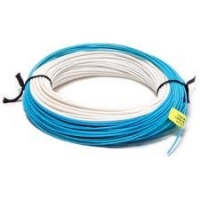
There are several things to consider when you want to choose a fly line. This guide will explain these and give you more of an insight so the next line you purchase will be ideal for the fly fishing you do. The things to consider are;
Target Species Fished for
Firstly we need to know what we are targeting. If it’s a small species like wild brown trout up to 1.5 lb then this will have a bearing on our overall line. A line of 5-7 weight would be fine here. The other aspect of target species is the size of the flies it will take to catch them. A trout for example can be caught on flies sized from 18 to 10 give or take a few. A pike however needs something a bit bigger say 2/0, 3/0 or larger. These larger flies need a larger weight set up to throw them properly and therefore something from an 8 weight up will be required.
You can fish for many species with the same line but the fine tuning of a target species line will enhance your ability to catch more fish. For example you can get fly lines for salt water species that would not work well in fresh water and vice versa but using a salt water line in the sea will give you the ability to cast further especially when there’s an onshore wind. These lines also have properties to protect them from the salt of the sea. Therefore look for a line specific to the species you are targeting. If targeting many species it would be better to get several lines unless they are all around the same size.
The Rod Line Rating
The rod line rating has the most to do with getting the correct line. The rating will be on the handle of the rod and you should match that figure with your line. That being said it is possible to go up or down a rating to improve casting when conditions are tough. For example when using a trout rod set up for a 4 weight line moving up to a 5 weight will help load the rod quicker and help in windy conditions. Moving down to a 3 weight would give you the ability to give better presentation which can be important when targeting easily spooked species. This is a more advanced technique but shows that you can cast lines that are not rated the same as the rod.
What Fly Line Density
It is important when deciding on a new fly fishing line to think about line density. The three main ones being full floater, intermediate and fast sinking lines. A selection of these are required to be able to cover all situations when fly fishing. There are also additions to fly lines called poly leaders which are made in several densities. These come in different lengths and when attached to the main fly line will give you the tool to fish different conditions.
For instance you can add a 5ft fast sink tip to a full floater line to help get your flies down quickly when fish are feeding at the bottom (or not showing) or when in fast deep water. More advanced anglers would suggest these leaders are OK to a point but the hinging effect at the joint interferes with the action of the cast. I tend to agree but they still do offer a quick solution when caught out without your favourite sink tip line. As a rule I always carry a wallet with a selection of poly leaders when going to the river to fly fish.
If you are a beginner I would recommend a full floating fly line which you can add poly leaders too in order to increase your condition range. Over time as you become more proficient at casting and are hooked to the sport..no pun intended...:-) you can purchase some more line densities. I would opt for an intermediate next followed by a mid range sinker. Then after that you can keep adding as new situation call for new lines.
What Fly Line Colour
The colour of the line is probably more down to personal taste than situation but there are times when a clear line helps if fish are again easily spooked. You can also get line that is in camouflage colours and so blend into the back ground a lot easier. However you can still fish with a bright yellow line and catch fish. I think it is more down to the leader length and fly presentation that the actual line colour.
There are many lines out on the market that have a change in colour at on the line. This colour change is a visual aid to show you when the line changes from the head down into the running line which you would set at a position on the rod to start another cast. This is not essential as a good waterproof marker can do the same thing once you take the new fly fishing line out and test where it loads the rod for casting.
I hope you found this information useful on how to choose a fly line please feel free to add any comment below, tight lines!
Why Road Cyclists Should Try Cyclocross in the Offseason

What Vacation Activities to Plan for In Shakopee

Golf Facts To Get You Into The Game

Copyright © www.mycheapnfljerseys.com Outdoor sports All Rights Reserved